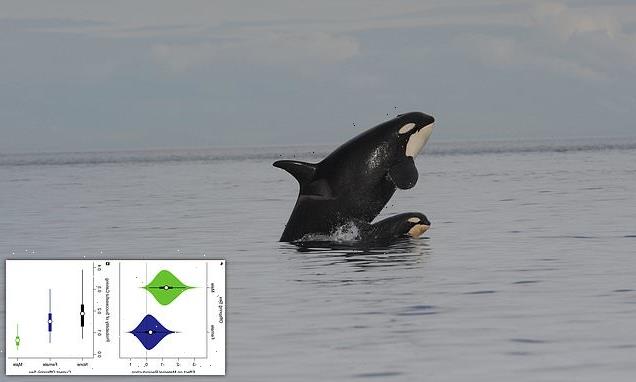Unbelievable moment a piece of the sun BREAKS OFF baffles scientists: Video shows plasma filament is now swirling around the northern pole like a tornado
- NASA captured the moment a piece of the sun’s northern pole broke off
- The object seen in the video is a solar filament, which is a cloud of ionized gas
- Another video from NASA shows the moon ‘photobombing’ the sun
The moment a piece of the sun’s northern pole breaks off has been captured by NASA in a never-before-seen event that has baffled scientists.
A video shows a giant filament of plasma, or electrified gas, shooting out from the sun, separating and then circulating in a ‘massive polar vortex.’
While astronomers are baffled, they speculate the prominence has something to do with the reversal of the sun’s magnetic field that happens once every solar cycle.
Solar physicist Scott McIntosh, the deputy director at the National Center for Atmospheric Research in Boulder, Colorado told Space.com: ‘Once every solar cycle, it forms at the 55-degree latitude and it starts to march up to the solar poles.’
A piece of the sun broke off and is circling the northern pole like a tornado. This is the first time scientists have seen such an event
The video was shared on Twitter by space weather forecaster Tamitha Skov, which said the clip was taken by NASA’s Solar Dynamics Observatory, which is currently investigating our star.
‘Talk about polar vortex! Material from a northern prominence just broke away from the main filament & is now circulating in a massive polar vortex around the north pole of our star,’ Skov shared in the tweet.
NASA describes solar filaments as clouds of charged particles that float above the sun, tethered to it by magnetic forces.
These appear as elongated, uneven strands that shoot out from the sun’s surface.
The prominence mentioned by Skov, appears precisely at the 55-degree latitude around the sun’s polar crowns every 11 years.
‘Once every solar cycle, it forms at the 55-degree latitude and it starts to march up to the solar poles,’ McIntosh told Space.com.
‘It’s very curious. There is a big ‘why’ question around it. Why does it only move toward the pole one time and then disappears and then comes back, magically, three or four years later in exactly the same region?’
While astronomers have previously observed filaments breaking away from the sun, this is the first time one has circulated the region in a whirlwind.
The video was shared on Twitter by space weather forecaster Tamitha Skov, which said the clip was taken by NASA’s Solar Dynamics Observatory, which is currently investigating our star
READ MORE: Amazing ultraviolet image of the sun appears to show a friendly expression
The sun hasn’t got his hat on here. But we can still cry hip hip hip hooray – because he’s wearing the broadest, warmest of smiles.
One instance was in 2015 when two long threads of solar material broke free from the sun and erupted into space.
The upper one broke first, sending dark plasma down toward an active region below it. An hour or two later, that lower filament erupted.
Scientists have yet to be determined what caused the filament in the recent observation to swirl around the sun instead of jetting out into space.
The recent increase in activity from the Sun results from it coming towards the most active phase in its 11-year solar cycle – hitting peak activity in 2024.
Astronomers are observing intense solar radiation, more ejection of solar materials, increased sunspots and more violent solar flares.
Studies have shown that the current solar activity level is about the same as it was 11 years ago, during the same point in the last cycle.
In August 2022, the European Space Agency’s (ESA) Gaia spacecraft made a chilling prediction that our sun is almost halfway through its life span.
When it reaches the end, it will swell and obliterate our planet – but data from the craft suggests this will not happen for at least another five billion years.
Gaia determined the sun is around 4.57 billion years old, and by identifying its mass and composition, the device estimated how the sun would evolve.
The road to its demise begins around 10 to 11 billion years of age when it becomes a red giant and rapidly increases significantly in size.
From here, the sun races to its death and finishes as a cool, dim white dwarf – the hot, dense core of a dead star.
Currently, the sun is deemed ‘middle-aged’ and stable as it fuses hydrogen into helium.
WHAT IS THE SOLAR CYCLE?
The Sun is a huge ball of electrically-charged hot gas that moves, generating a powerful magnetic field.
This magnetic field goes through a cycle, called the solar cycle.
Every 11 years or so, the Sun’s magnetic field completely flips, meaning the sun’s north and south poles switch places.
The solar cycle affects activity on the surface of the Sun, such as sunspots which are caused by the Sun’s magnetic fields.
Every 11 years the Sun’s magnetic field flips, meaning the Sun’s north and south poles switch places. The solar cycle affects activity on the surface of the Sun, increasing the number of sunspots during stronger (2001) phases than weaker (1996/2006) ones
One way to track the solar cycle is by counting the number of sunspots.
The beginning of a solar cycle is a solar minimum, or when the Sun has the least sunspots. Over time, solar activity – and the number of sunspots – increases.
The middle of the solar cycle is the solar maximum, or when the Sun has the most sunspots.
As the cycle ends, it fades back to the solar minimum and then a new cycle begins.
Giant eruptions on the Sun, such as solar flares and coronal mass ejections, also increase during the solar cycle.
These eruptions send powerful bursts of energy and material into space that can have effects on Earth.
For example, eruptions can cause lights in the sky, called aurora, or impact radio communications and electricity grids on Earth.
Source: Read Full Article






